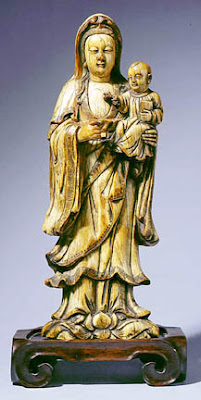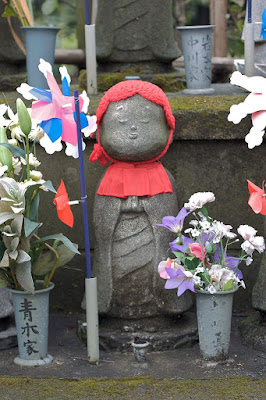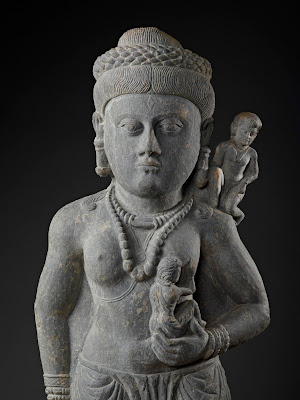Saint Dymphna, as patronness of the mentally ill, has a colleague in the Far East. And she is not obscure.
Recall that the First Noble Truth of Buddhism, on which all else is based, is that “all existence is dukkha (suffering, ill-being).” This surely is an appeal to the depressed, like Jesus’s Beatitudes. Although Buddhism holds that the depressed see the world as it really is. Everyone else is deluded.
The objective of Mahayana Buddhism, the form of Buddhism practiced in China, Korea, and Japan, is not to become a Buddha. That is an admirable, but a lesser, goal. It is to become a Bodhisattva. A Bodhisattva is a soul who has earned all the merit necessary to become an enlightened Buddha, but nevertheless refuses this until they can first, through their merits, bring enlightenment to every other existing soul. This is, morally, a higher achievement; it shows perfect selflessness.
And it is just the sort of goal a depressed person might aspire to.
Walpola Rahula, the eminent Theravada Buddhist scholar and monk, asserts that the Bodhisattva ideal is also the highest goal of the Southern school of Buddhism, found in Sri Lanka and Thailand. He writes, “both the Theravada and the Mahayana unanimously accept the Bodhisattva ideal as the highest” (Rahula, The Bodhisattva Ideal in Buddhism, Buddhist Missionary Society, 1996).
Among named Bodhisattvas honoured by Buddhists, one is preeminent: the being called Guan Yin in China, Kwannon in Japan, Kwanseum in Korea, or Avalokitesvara in Sanskrit.
Once upon a time she was, like Dymphna, a beautiful princess. In China, even today, when a child is exceptionally pretty, she is compared to Guan Yin: “To say a lady or a little girl is a ‘Kuan Yin’ is the highest compliment that can be paid to grace and loveliness.” Guan Yin, or Miao Shan, as she was known in this earthly life, was also exceptionally moral in her conduct, “naturally kind and gentle.” The gods themselves say, “there is none in the west so noble as this Princess” (Edward Werner, Myths and Legends of China, 1922). And she was born with the distinguishing marks that predicted she would become a Buddha.
Nevertheless—or perhaps because of this; the legend is unclear—her parents despised her. The locus classicus for the basic story is Tsu-hsiu, Lung-hsing fo-chiao pien-nien t'ung-lun, written around 1164 AD.
When Miao Shan/Guan Yin reached adolescence, her father demanded that she marry. This is a reversal of the usual story in the West, in which the king prevents his daughter from meeting any men; but the essential issue is the same. The king will not permit his daughter her own life. He is demanding her desires be sacrificed to his.
He had seized his kingdom by force, and was concerned about the succession. Miao Shan had two older sisters, also lovely, who had already married the kingdom’s top scholar and its top general; but this was not enough for Miao Shan’s father. He wanted a third line with backup heirs in case of need. When she told him she would prefer solitary meditation, as a Buddhist nun, he would not permit it.
To punish his daughter for intransigence, the king banishes her to the green world—to the Queen’s private garden. This is what usually happens to heroines at adolescence. Predictably, however, Miao Shan is content there. So her father banishes her to the Nunnery of the White Bird, with instructions to make her life difficult. “The nuns were intimidated and gave her the heaviest tasks to do--fetching wood and water, working with pestle and mortar, and running the kitchen garden.”
A tiger appears and spirits away her corpse to the green world. In the meantime, her spirit, like that of Psyche, descends to the land of the dead. There, all the kings of hell greet her respectfully. She, however, is still self-deprecating.
“Who am I,” asked Miao Shan, “that you should deign to take the trouble to show me such respect?” (Werner)
She is then returned to her body, being too pure for hell, and finds herself alone in the pine forest. Another tiger appears. Miao Shan, as one might expect from someone depressed, is ready to die for assumed guilt:
“‘I am a poor girl devoid of filial piety,’ said Miao Shan when she came up. ‘I have disobeyed my father’s commands; devour me, and make an end of me.’”
The tiger, however, transports her the many miles to the island of Pu-tuo, where, after nine years in meditation, she achieves the merit to become enlightened.
In the meantime, her father falls ill. He is told that only the eyes and hands of another, ground up as a salve, will cure him.
Miao Shan offers hers, both hands and both eyes; and he is cured.
 |
| Many may disagree, but for my money, nobody does Kwanseum better than the Koreans. |
Although in this case voluntary, here is an image comparable to that of the parent eating the child. The child is sacrificed for the parent’s benefit.
At the same time, it is dramatic proof of selfless love on Miao Shan’s part.
However, the story is not yet over. As in the Western fairy tales, the heroine also has to experience selfless love from another.
Miao Shan’s “Prince Charming” is named Shancai (Shan Ts’ai; Sudhana in Sanskrit), a young crippled orphan who has also sought solitude as a Buddhist monk. He comes to her island retreat—his green world—seeking instruction. Asked to identify himself, he says, as one might expect from a depressed person, “I am a poor orphan priest of no merit.”
Guan Yin/Miao Shan then sets him a test of devotion. She stages a raid by pirates, in which her life appears to be threatened. The pirates chase her to the edge of a cliff, and she jumps off.
Shancai, the supplicant, meets the test. He leaps after her, hoping to save her, proves his true love, and dies. At this moment, Shancai loses his disability, is able to walk, and becomes handsome. Although they do not kiss, both Miao Shan and Shancai dissolve in tears. The curse, or the mental illness, is lifted. They meditate happily ever after.
Shancai is often shown in iconography as a small child cradled by Guan Yin: she is seen, apparently on the basis of this legend, as the protector, especially, of small children.
 |
| Guan Yin with Shancai |
Miao Shan thus became Guan Yin, the Bodhisattva of infinite compassion, who listens for the cries of the suffering, and will extend a hand to help. Through her merits, her two sisters also became Bodhisattvas, Samantabadhra and Manjusri.
There are other traditions of Guan Yin. In one, the son of the dragon king, disguised as a carp, is caught by fishermen. The fish, being magical, does not die when it is brought ashore and to market. This causes a great deal of interest: people offer huge sums for this immortal fish, because they assume that by eating it they can obtain eternal life. Guan Yin sends Shancai to buy the fish instead, in order to set it free.
He cannot match the sums being offered. Nevertheless, Guan Yin herself intervenes by declaring from aloft in a loud voice that “a life belongs to the one who wants to save it, not to take it.” Which settles the matter—and offers a parable of the good parent and true love similar to the story of Solomon’s judgement in the Bible.
Together, Guan Yin and her sisters Manjusri and Samantabadhra, whose merit is a reflection of hers, are three of best-known Bodhisattvas. The fourth is Ksitigarbha (Sanskrit) / Dizang or Ti Tsang (Chinese) / Chi jiang (Korean) / Jizo (Japanese). He too was once a mortal woman, a Brahmin child in India named Sacred Girl. He is usually, unlike Guan Yin, portrayed as male. But souls are neither male nor female, and are only arbitrarily portrayed as one or the other, depending on the legends of their incarnations.
Sacred Girl’s mother, according to the sutras, was a great sinner. Perhaps her sins included abuse of her child; this is not said. She then died and went straight to hell. Sacred Girl, however, did great penances, ultimately descended herself, like Psyche and Guan Yin, into hell, and, by her own merits, rescued her mother (M. W. De Visser, The Bodhisattva Ti Tsang [Jizo] in China and Japan, Berlin, 1914, pp. 9-10).
She then vowed to do the same for all comers; everyone in hell. Interestingly, however—and this hints at some unspoken back-story—she/he is appealed to especially to protect children who have died.
According to Japanese tradition, children who die are confronted on a beach in the underworld by a malicious female demon, who requires them to pile up stones before they are allowed to move on to the next life. Demons then come and knock down the stone towers, requiring them to do it all over again, eternally. “Devils strike those stüpas with iron sticks. Then the boys slowly go back again and pile the pebbles up, but the devils reappear and again destroy the stüpas, so that the work is never finished” (de Visser, p. 119). Jizo, however, descends and allows them to escape this.
Might this be an image of mental illness? Is “death” here a metaphor for a spiritual death? It sounds like the trials of tidiness faced by heroines in fairy tales.
Indeed, Ksitigarbha / Jizo is said to help not only those in hell, but “those who are troubled by spirits and nightmares.”
There are other legends, specifically of Jizo helping abused children. The tale is told in Kochima, for example, of a boy whose mother died, and whose stepmother despised him. While his father was absent, she seized him and threw him in the cooking pot to boil him for soup.
In the meantime, the father, travelling along a road, encountered an old monk with a little boy on his back. It was, he realized, his own son! The monk handed him the boy, telling him to put him in another’s care, because his mother wanted to kill him.
The father rushed home, pulled off the lid of the cooking pot, and saw the family’s statue of Ksitigarbha, boiling away. Ksitigarbha had offered himself in place of the child; and had then appeared to him as the old monk on the road (de Visser, p. 134).
In another tale, from the Kwösekishü, a 17th century compilation, a cruel and abusive stepmother requires her son to put an offering of rice in the hands of the family statue of Jizo / Ksitigarbha. She knows he is too small to reach the statue’s hands, but will not feed him until he does. This is a typical bit of gaslighting: making the child take the blame for the cruelty committed by the parent.
The statue, however, comes alive, reaches down, and takes the rice.
The child returns, saying he has accomplished the mission. The mother beats him for lying.
This is an illustration of a typical “double-bind,” to use R.D. Laing’s term: whatever the abused child does, must have been the wrong thing.
But after the child begs her to go and look for herself, she sees that the statue is indeed holding the rice. Not only that: there are grains sticking near his mouth indicating he has eaten some.
She is shocked by this out of treating the boy so badly (de Visser, p. 169).
In Japan today, women who have had abortions will buy baby clothing, toys and candies, and present them to a statue of Jizo as a penitential offering.
 |
| Jizo wearing knit offerings. |
More obscure, but still known from India to Japan, is the figure of Hariti, considered a goddess by both Hindus and Buddhists. She was originally a rakshini, a demon or evil spirit, who had 500 children, and ate all of them but the last. The Buddha himself rescued her last child by hiding him under his alms bowl, then converted her, and she became instead a protectoress of children (Alice Getty, The Gods of Northern Buddhism, Oxford, 1914, p. 75).
 |
| Hariti |
Surely this is evidence enough that the issue of child abuse is a traditional concern in the East as well as in the West; and is understood in essentially the same terms. An abused or neglected childhood causes depression, which causes a need for solitude. The depression is cured by trials of virtue and then by expressions of selfless love. The selfless love, which in the West comes from Jesus, can come here instead from Guan Yin or Ksitigarbha.





















































